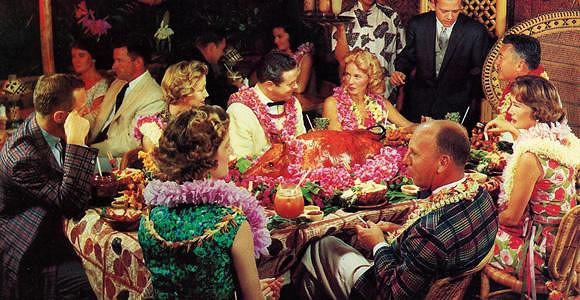Tiki Central / General Tiki / TIKI in the news...Past and Present
Post #609943 by SoccerTiki on Wed, Oct 12, 2011 10:51 AM
|
S
SoccerTiki
Posted
posted
on
Wed, Oct 12, 2011 10:51 AM
I just read this article from the Atlantic Monthly: From Tiki to Tacky—and Back America’s ongoing cocktail revival isn’t a single, monolithic scene, but rather a theme park composed of many small villages inhabited by historic reenactors. Faux 19th-century bartenders in sleeve garters and baroque facial hair ply their trade in pre-Prohibition bars. Women wearing cloche hats order sidecars at speakeasies. You can sip daiquiris to a rumba beat in an ersatz Cuban bar, or martinis served by Brylcreemed waiters at a Mad Men–styled lounge. But none of these villages approaches, in sheer rococo verve, the thatch-roofed splendor of tiki. Tiki drinks have been around since 1934, when Don the Beachcomber opened in Los Angeles, followed shortly thereafter by Trader Vic’s in Oakland. The two became chains that expanded steadily, and together created a nationwide sensation that peaked in the late 1950s and early ’60s. Polynesian food and drink—or rather, “Polynesian” food and drink, because real islanders favored bland tubers and a beverage made with their own spit—became synonymous with the Big Night Out. Difficult as it is to recollect today, tiki was a highbrow phenomenon: Trader Vic’s in the Washington, D.C., Hilton, for instance, became a famed venue for mid-century power lunches. Alas, the success of Don and Vic spawned a herd of garish strip-mall imitators, and it wasn’t long before tiki lapsed into kitsch, decadence, and decay. One can even pinpoint the precise nadir: in 1989, Donald Trump closed the Trader Vic’s at his Plaza Hotel in New York, declaring that it had “gotten tacky.” But like John Travolta, ABBA, and Morris Lapidus, tiki slogged through its unfashionable period and eventually emerged on the other side. The tiki scene is now in full flower in locales as far-flung as New York, London, Moscow, and Bratislava, Slovakia. “The common thread is the lifestyle,” says Christie White, who founded and runs the Hukilau, an annual tiki gathering in Fort Lauderdale. This year, the event attracted some 600 people who donned muumuus, fezzes, and Hawaiian shirts to listen to music from the Tikiyaki Orchestra and enjoy an aquatic performance by Marina the Fire Eating Mermaid. But there’s another, less campy reason for the tiki resurgence. The original cocktails, it turns out, are very tasty. “The drinks were bound to be rediscovered,” says Jeff “Beachbum” Berry, the author of the forthcoming Potions of the Caribbean and several other tiki books. “They’re just intrinsically good.” What distinguishes a tiki drink is its complexity. The characteristic use of multiple rums—say, a white Martinique rum combined with a heavy Jamaican rum—creates initial intrigue. This base is tweaked, in many cases, with a hint of Pernod or falernum syrup, adding flavors that linger just barely at the threshold of perception. Tiki’s signature drink, the Mai Tai—unlike the sweet, fruity drinks that have subsequently borne its name—was originally a concoction of rums and fresh lime juice, given an ineffable twist with a dash of almond-flavored orgeat. This year’s Hukilau was staged partially at the Mai-Kai Restaurant, which is the Angkor Wat of tiki culture. (Full disclosure: Berry and I appeared there on a panel together.) The restaurant opened in 1956 and has remained essentially unchanged ever since, an oasis of shrunken heads, tiki totems, and tiny waterfalls. Berry calls it “the last perfectly preserved example of mid-century Polynesian pop.” Berry says the recent tiki trend began with a healthy dose of irony in the 1990s, and many thought it would prove another fleeting hipster fad. But then it collided with the broader cocktail renaissance. “Craft bartenders,” Berry explains, “knew how to make three- or four-ingredient drinks. This was a way for them to take on a 10- to 12-ingredient punch.” Sitting at the Mai-Kai, sipping the bar’s Special Planter’s Punch—a pitch-perfect re-creation of a classic 1930s drink—I enjoyed a nostalgia every bit as complicated as the drink itself. I found myself pining for a Gauguinesque South Pacific that’s long since vanished, if it ever existed. Yet more than that, I found myself wistful for a mid-century America where one could slip away, for a moment, by walking over a low bridge into a damp fake grotto and ordering a subtle rum drink served in an Easter Island–head mug. This article available online at: http://www.theatlantic.com/magazine/archive/2011/11/from-tiki-to-tacky-and-back/8666/ Copyright © 2011 by The Atlantic Monthly Group. All Rights Reserved. |

